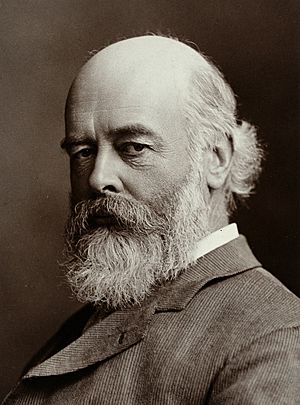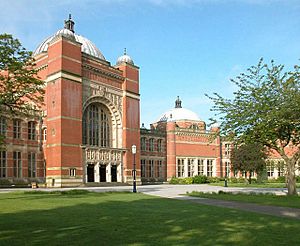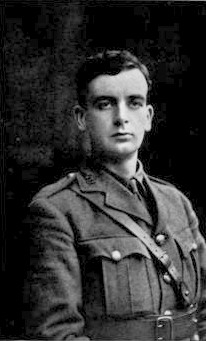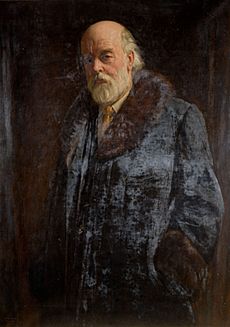Oliver Lodge facts for kids
Quick facts for kids
Sir Oliver Lodge
|
|
|---|---|
 |
|
| Born |
Oliver Joseph Lodge
12 June 1851 Penkhull, Staffordshire, England
|
| Died | 22 August 1940 (aged 89) |
| Occupation | Physicist and inventor |
| Known for | Radio Radio control Loudspeaker Moving boundary method Waveguide Maxwell-Lodge effect |
| Awards |
|
Sir Oliver Joseph Lodge (born June 12, 1851 – died August 22, 1940) was a famous British scientist and writer. He played a big part in developing early radio technology. He even held important patents for radio inventions. Lodge was one of the first to discover electromagnetic radiation, which are the waves that make radio work. He did this even before Heinrich Hertz proved they existed.
In 1894, Lodge showed off an early radio wave detector. He called it a "coherer". Later, in 1898, he received a special patent for "syntonic" (or tuning) radio. This allowed radio signals to be sent and received on specific frequencies. Sir Oliver Lodge was also the first leader of the University of Birmingham from 1900 to 1920.
Besides his science work, Lodge was known for his belief in Spiritualism. This is the idea that people can communicate with spirits of the dead. He wrote many books about life after death. His most famous book was Raymond; or, Life and Death (1916). In it, he described messages he believed he received from his son, Raymond. Raymond had died in World War I.
Contents
Early Life and Education
Oliver Lodge was born in 1851 in a village called Penkhull in England. This area is now part of Stoke-on-Trent. He went to Adams' Grammar School. His father, Oliver Lodge, was a merchant who sold special clay. Oliver was the first of eight sons and one daughter. His siblings included Sir Richard Lodge, a historian, and Eleanor Constance Lodge, also a historian.
When Oliver was 12, his family moved to Wolstanton. There, he used an outbuilding for his first science experiments. At 14, he left school to work for his father's business. He sold clay to pottery makers. This job sometimes took him far away, even to Scotland. He worked with his father until he was 22.
As his family became wealthier, they moved to Chatterley House. From there, Lodge attended physics lectures in London. He also went to the Wedgwood Institute for studies. Around 1869, he started doing "real experiments" at Chatterley House.
In 1875, his family moved again to Watlands Hall. Lodge earned a Bachelor of Science degree from the University of London in 1875. He then got his Doctor of Science title in 1877. During this time, he experimented with creating a new kind of "electromagnetic light." This work helped him succeed in later experiments. He also taught at Bedford College, London.
Career and Achievements
In 1881, Lodge left his hometown. He became a Professor of Physics and Mathematics at the new University College, Liverpool. In 1900, he moved back to the Midlands. He became the first leader, or Principal, of the new Birmingham University. He stayed there until he retired in 1919. He helped the university move from the city center to its current campus.
Lodge received the Rumford Medal in 1898 for his scientific work. He was also made a knight in 1902 by King Edward VII. This meant he could use "Sir" before his name. In 1928, he was honored as a "Freeman" of his hometown, Stoke-on-Trent.
Lodge married Mary Fanny Alexander Marshall in 1877. They had twelve children, six boys and six girls. Four of his sons used his inventions in their businesses. Two sons, Brodie and Alec, started the Lodge Plug Company. This company made spark plugs for cars and airplanes. Other sons, Lionel and Noel, created a company that cleaned factory smoke.
After retiring in 1920, Lodge and his wife lived in Wiltshire. They are buried at a local church there.
Electromagnetism and Radio
In 1873, J. C. Maxwell published an important book about electricity and magnetism. Lodge studied it very carefully. Lodge became interested in making and finding electromagnetic waves around 1879. Maxwell had not thought about this.
Lodge also studied lightning and how lightning rods work. He found that lightning sometimes took unexpected paths. He simulated lightning using Leyden jars and copper wire. He discovered that the electrical charge would sometimes jump a spark gap instead of following a longer wire. This showed the effect of inductance on electricity.
In 1888, Lodge did more experiments. He put spark gaps along long wires. He saw large sparks at the end of the wires. This showed that waves were bouncing back. He also saw a glow along the wire at certain points. He believed this proved he was creating and detecting Maxwell's electromagnetic waves. While on vacation, he read that Heinrich Hertz in Germany had already published his own research. Hertz had proven the existence of electromagnetic waves. Lodge quickly added a note to his own paper, recognizing Hertz's important work.
On June 1, 1894, Lodge gave a lecture about Hertz's work. Hertz had recently passed away. Lodge showed how "Hertzian waves" (radio waves) were like light. He demonstrated how they could be reflected and transmitted. He used a detector called a coherer. This was a glass tube with metal filings. When radio waves hit it, the filings would stick together. This made the tube conduct electricity. Lodge's setup used a mirror galvanometer to show when a signal was received. After a signal, the filings had to be broken apart. This was done by hand or by a bell ringing nearby.
This demonstration was a year before Marconi showed his radio system. Lodge's lecture had many parts that Marconi later used. This led to arguments later about who invented wireless telegraphy (radio). Some people said Lodge's lecture was just a science experiment. It was not a demonstration of sending messages. Lodge later worked with Alexander Muirhead to make devices for wireless telegraphy.
In 1898, Lodge received a patent for "syntonic" tuning. This allowed radio transmitters and receivers to use specific frequencies. Marconi also had a similar system. In 1912, Marconi bought Lodge's syntonic patent. Lodge then became a "scientific adviser" to Marconi's company.
Other Scientific Work
In 1886, Lodge created a method to measure how ions move in a solution. This is called the moving boundary method.
Lodge also studied Voltaic cells and electrolysis. He worked on using electricity to clear fog and smoke. He made a big contribution to cars by inventing a type of electric spark ignition for engines. This was called the Lodge Igniter. Later, two of his sons developed his ideas. In 1903, they started Lodge Bros, which became Lodge Plugs Ltd. He also made discoveries in wireless transmission. In 1898, Lodge got a patent for the moving-coil loudspeaker.
Lodge was also involved in politics. He was a member of the Fabian Society. This group promoted social reform. He wrote papers on topics like "Socialism & Individualism."
He was President of the Liverpool Physical Society from 1889 to 1893. In 1901, he became a member of the American Philosophical Society. Lodge was also President of the British Science Association from 1912 to 1913. In his speech, he said he believed that human personality continues after death. He also believed in communicating with spirits and in the aether theory.
Spiritualism and Beliefs
Lodge is also remembered for his interest in psychical research and spiritualism. He started studying things like telepathy in the late 1880s. He was president of the Society for Psychical Research from 1901 to 1903.
His son, Raymond, was killed in World War I in 1915. After this, Lodge visited several mediums. He wrote about his experiences in books, including Raymond; or, Life and Death (1916). Lodge was friends with Arthur Conan Doyle, who also lost a son in the war and believed in Spiritualism.
Lodge was a Christian Spiritualist. In 1909, he wrote Survival of Man. In this book, he said that life after death had been proven by mediums. His book Raymond or Life and Death (1916) was very famous. It described the séances he and his wife had with a medium named Gladys Osborne Leonard. Lodge was sure that his son Raymond had talked to him. The book described Raymond's experiences in the spirit world. Raymond supposedly said that people were the same after they died. He also said there were houses, trees, and flowers in the spirit world, much like on Earth, but without sickness. The book also claimed that soldiers who died in World War I could smoke cigars and drink whisky in the spirit world. Because of these claims, the book was criticized by some.
Lodge believed that the spirit world existed in the ether. The ether was a scientific idea at the time about a substance that filled the universe. He also believed in spiritual evolution. He wrote about this in books like Man and the Universe (1908).
Tributes
Lodge received an honorary Doctor of Laws (LL.D) degree from the University of Glasgow in 1901.
The newspaper The Times wrote about him after he died:
Always an impressive figure, tall and slender with a pleasing voice and charming manner, he enjoyed the affection and respect of a very large circle…
Lodge’s gifts as an expounder of knowledge were of a high order, and few scientific men have been able to set forth abstruse facts in a more lucid or engaging form… Those who heard him on a great occasion, as when he gave his Romanes lecture at Oxford or his British Association presidential address at Birmingham, were charmed by his alluring personality as well as impressed by the orderly development of his thesis. But he was even better in informal debate, and when he rose, the audience, however perplexed or jaded, settled down in a pleased expectation that was never disappointed.
There is an Oliver Lodge Primary School in Vanderbijlpark, South Africa, named after him. In Liverpool, there is a bronze statue called Education at the Queen Victoria Monument that honors him. The Oliver Lodge Building at the University of Liverpool also houses its physics department.
Images for kids
See also
 In Spanish: Oliver Joseph Lodge para niños
In Spanish: Oliver Joseph Lodge para niños






